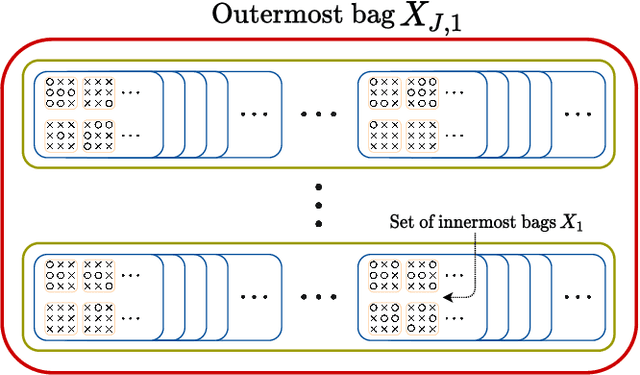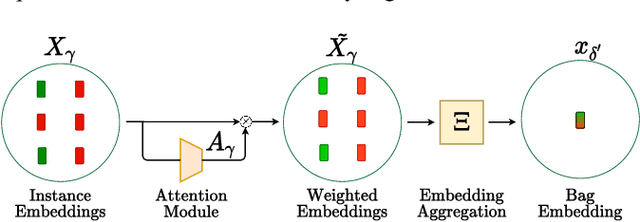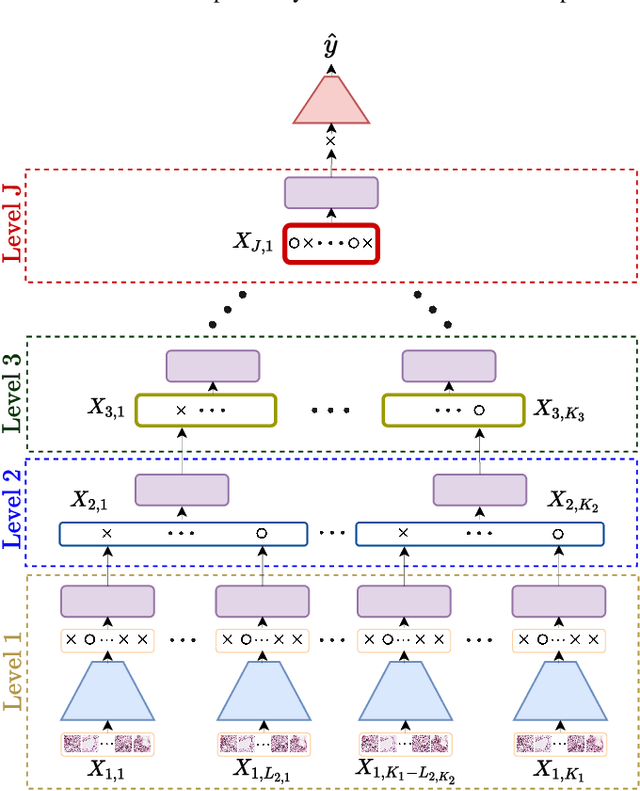Saul Fuster
NMGrad: Advancing Histopathological Bladder Cancer Grading with Weakly Supervised Deep Learning
May 24, 2024Abstract:The most prevalent form of bladder cancer is urothelial carcinoma, characterized by a high recurrence rate and substantial lifetime treatment costs for patients. Grading is a prime factor for patient risk stratification, although it suffers from inconsistencies and variations among pathologists. Moreover, absence of annotations in medical imaging difficults training deep learning models. To address these challenges, we introduce a pipeline designed for bladder cancer grading using histological slides. First, it extracts urothelium tissue tiles at different magnification levels, employing a convolutional neural network for processing for feature extraction. Then, it engages in the slide-level prediction process. It employs a nested multiple instance learning approach with attention to predict the grade. To distinguish different levels of malignancy within specific regions of the slide, we include the origins of the tiles in our analysis. The attention scores at region level is shown to correlate with verified high-grade regions, giving some explainability to the model. Clinical evaluations demonstrate that our model consistently outperforms previous state-of-the-art methods.
Self-Contrastive Weakly Supervised Learning Framework for Prognostic Prediction Using Whole Slide Images
May 24, 2024



Abstract:We present a pioneering investigation into the application of deep learning techniques to analyze histopathological images for addressing the substantial challenge of automated prognostic prediction. Prognostic prediction poses a unique challenge as the ground truth labels are inherently weak, and the model must anticipate future events that are not directly observable in the image. To address this challenge, we propose a novel three-part framework comprising of a convolutional network based tissue segmentation algorithm for region of interest delineation, a contrastive learning module for feature extraction, and a nested multiple instance learning classification module. Our study explores the significance of various regions of interest within the histopathological slides and exploits diverse learning scenarios. The pipeline is initially validated on artificially generated data and a simpler diagnostic task. Transitioning to prognostic prediction, tasks become more challenging. Employing bladder cancer as use case, our best models yield an AUC of 0.721 and 0.678 for recurrence and treatment outcome prediction respectively.
A Dual Convolutional Neural Network Pipeline for Melanoma Diagnostics and Prognostics
Dec 14, 2023Abstract:Melanoma is a type of cancer that begins in the cells controlling the pigment of the skin, and it is often referred to as the most dangerous skin cancer. Diagnosing melanoma can be time-consuming, and a recent increase in melanoma incidents indicates a growing demand for a more efficient diagnostic process. This paper presents a pipeline for melanoma diagnostics, leveraging two convolutional neural networks, a diagnosis, and a prognosis model. The diagnostic model is responsible for localizing malignant patches across whole slide images and delivering a patient-level diagnosis as malignant or benign. Further, the prognosis model utilizes the diagnostic model's output to provide a patient-level prognosis as good or bad. The full pipeline has an F1 score of 0.79 when tested on data from the same distribution as it was trained on.
Deep Learning for Predicting Metastasis on Melanoma WSIs
Mar 10, 2023Abstract:Northern Europe has the second highest mortality rate of melanoma globally. In 2020, the mortality rate of melanoma rose to 1.9 per 100 000 habitants. Melanoma prognosis is based on a pathologist's subjective visual analysis of the patient's tumor. This methodology is heavily time-consuming, and the prognosis variability among experts is notable, drastically jeopardizing its reproducibility. Thus, the need for faster and more reproducible methods arises. Machine learning has paved its way into digital pathology, but so far, most contributions are on localization, segmentation, and diagnostics, with little emphasis on prognostics. This paper presents a convolutional neural network (CNN) method based on VGG16 to predict melanoma prognosis as the presence of metastasis within five years. Patches are extracted from regions of interest from Whole Slide Images (WSIs) at different magnification levels used in model training and validation. Results infer that utilizing WSI patches at 20x magnification level has the best performance, with an F1 score of 0.7667 and an AUC of 0.81.
Active Learning Based Domain Adaptation for Tissue Segmentation of Histopathological Images
Mar 09, 2023Abstract:Accurate segmentation of tissue in histopathological images can be very beneficial for defining regions of interest (ROI) for streamline of diagnostic and prognostic tasks. Still, adapting to different domains is essential for histopathology image analysis, as the visual characteristics of tissues can vary significantly across datasets. Yet, acquiring sufficient annotated data in the medical domain is cumbersome and time-consuming. The labeling effort can be significantly reduced by leveraging active learning, which enables the selective annotation of the most informative samples. Our proposed method allows for fine-tuning a pre-trained deep neural network using a small set of labeled data from the target domain, while also actively selecting the most informative samples to label next. We demonstrate that our approach performs with significantly fewer labeled samples compared to traditional supervised learning approaches for similar F1-scores, using barely a 59\% of the training set. We also investigate the distribution of class balance to establish annotation guidelines.
Nested Multiple Instance Learning with Attention Mechanisms
Nov 02, 2021



Abstract:Multiple instance learning (MIL) is a type of weakly supervised learning where multiple instances of data with unknown labels are sorted into bags. Since knowledge about the individual instances is incomplete, labels are assigned to the bags containing the instances. While this method fits diverse applications were labelled data is scarce, it lacks depth for solving more complex scenarios where associations between sets of instances have to be made, like finding relevant regions of interest in an image or detecting events in a set of time-series signals. Nested MIL considers labelled bags within bags, where only the outermost bag is labelled and inner-bags and instances are represented as latent labels. In addition, we propose using an attention mechanism to add interpretability, providing awareness into the impact of each instance to the weak bag label. Experiments in classical image datasets show that our proposed model provides high accuracy performance as well as spotting relevant instances on image regions.
 Add to Chrome
Add to Chrome Add to Firefox
Add to Firefox Add to Edge
Add to Edge